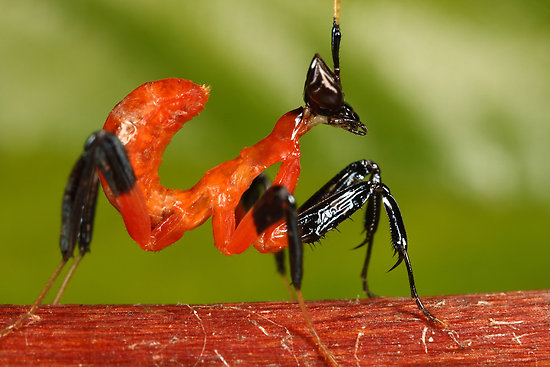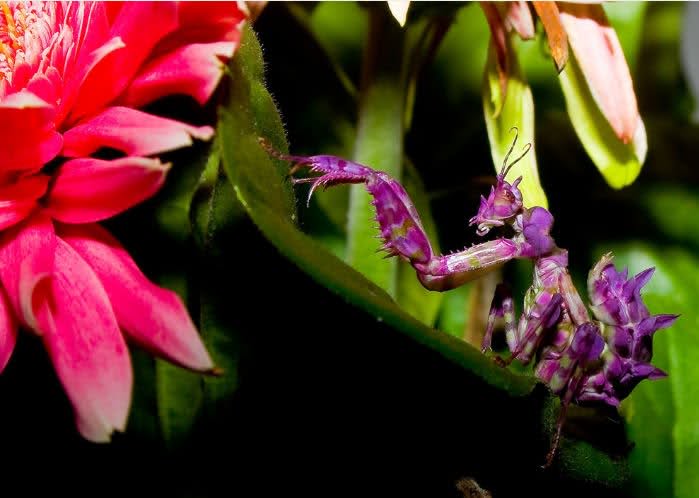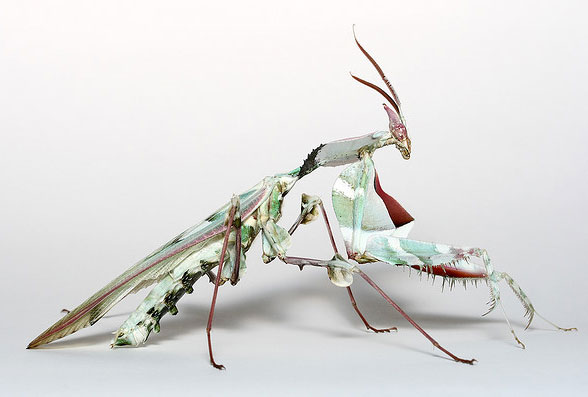It looks like you're using an Ad Blocker.
Please white-list or disable AboveTopSecret.com in your ad-blocking tool.
Thank you.
Some features of ATS will be disabled while you continue to use an ad-blocker.
12
share:
LYING LIKE AN ORCHID An orchid mantis (top) catches insects that come too close, tricked by the insect’s flowerlike appearance. Close-up views of another orchid mantis (bottom) show it feeding on prey.
Orchid mantises have evolved into a fake flower that out-flowers the real thing. The insects don’t seem to be mimicking any real flower found so far, but have invented something even fancier. Among the many oddly shaped mantises of the world, only the petal-legged, corsage-worthy orchid mantis (Hymenopus coronatus) comes close to counterfeiting a whole blossom, says James O’Hanlon of Macquarie University in Sydney. Which can be a nuisance. Searching rainforests for orchid mantises to study is “very frustrating,” O’Hanlon says. “Every time you see a flower you go nuts thinking you’ve found one, and then it’s just a flower.” This resemblance led Alfred Russel Wallace, the largely forgotten also-ran of evolutionary theory, to propose that the phony flowers lure a pollinator close enough to grab in an eye-blink strike. (They can rip apart a butterfly thrice their size.)
Read more HERE
Another fascinating adaptation in the animal kingdom to facilitate its success. I can imagine it would be very hard to find one of these mantises they make Waldo look like a rank amateur.
reply to post by Grimpachi
Nice video! S&F. This is what the first instar of the Orchid mantis looks like:

From Wikipedia:
another flower mantis

and the Devil's Flower mantis

Nice video! S&F. This is what the first instar of the Orchid mantis looks like:

From Wikipedia:
An instar (from the Latin "form", "likeness") is a developmental stage of arthropods, such as insects, between each molt (ecdysis), until sexual maturity is reached.[1] Arthropods must shed the exoskeleton in order to grow or assume a new form. Differences between instars can often be seen in altered body proportions, colors, patterns, or changes in the number of body segments. Some arthropods can continue to molt after sexual maturity, but these subsequent molts are generally not called instars.
another flower mantis

and the Devil's Flower mantis

new topics
-
Let's talk planes.
General Chit Chat: 7 hours ago -
January 6th report shows disturbing trend (nobody is shocked)
US Political Madness: 8 hours ago -
Inexplicable military simulation - virtual reality showdown in the night..
The Gray Area: 9 hours ago -
The Truth about Migrant Crime in Britain.
Social Issues and Civil Unrest: 10 hours ago
top topics
-
Trudeau Resigns! Breaking
Mainstream News: 12 hours ago, 26 flags -
January 6th report shows disturbing trend (nobody is shocked)
US Political Madness: 8 hours ago, 20 flags -
Live updates: Congress meets to certify Trump's presidential election victory
US Political Madness: 13 hours ago, 12 flags -
The Truth about Migrant Crime in Britain.
Social Issues and Civil Unrest: 10 hours ago, 10 flags -
Gravitic Propulsion--What IF the US and China Really Have it?
General Conspiracies: 13 hours ago, 9 flags -
Let's talk planes.
General Chit Chat: 7 hours ago, 5 flags -
Greatest thing you ever got, or bought?
General Chit Chat: 13 hours ago, 4 flags -
Inexplicable military simulation - virtual reality showdown in the night..
The Gray Area: 9 hours ago, 2 flags
12

